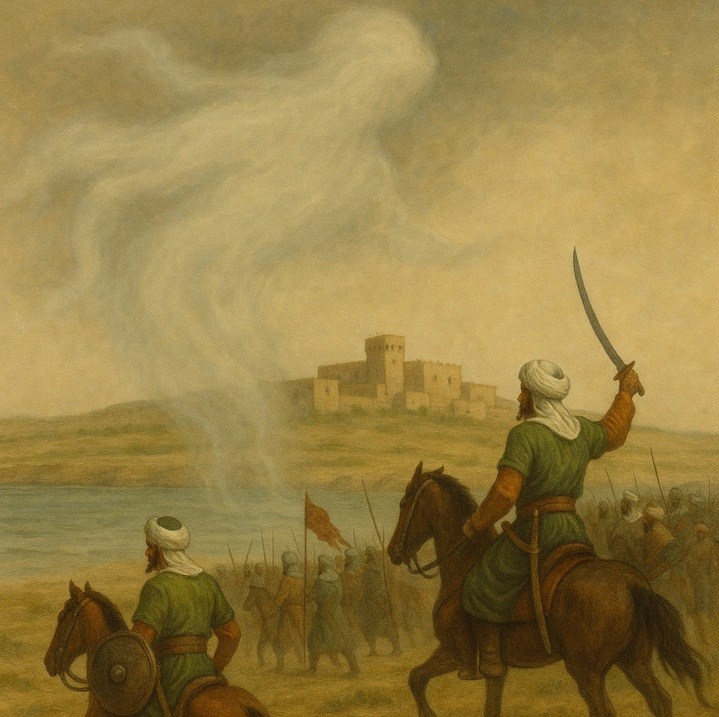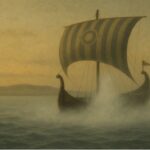| Malta Short Let: Cozy Stay in Gzira | |
|
Sliema Area Modern Designer Finished 2 Bedrooms + Games Room. First floor with Maltese Balcony Large back Terrace with swinging sofa Fully Airconditioned + Full Kitchen 3 TVs, including 65” with backlight. |
 |
|
Book Now: Google Travel | Direct (Cheapest) | Booking.com | Airbnb |
|
DISCLAIMER
This is a work of fiction. While it incorporates historical events, all characters, conversations, and supernatural elements are fictional. Any resemblance to real persons beyond general historical context is coincidental. Historical liberties have been taken for narrative purposes. Future chapters are speculative fiction only. All rights reserved ManicMalta.com. This book cannot be reproduced in part or in full, copied or printed. For the full disclaimer on this book see this page : Il-Ħares fictional book disclaimer.
THE CRESCENT MOON
I have known many conquerors. Most arrive with swords drawn and promises ready.
The Arabs were no different.
What was different was what they left behind.
Words.
Hundreds of them, nestled into the language of my people like seeds in soil. The very name they would call me – Il-Ħares – carries the breath of their tongue.
But I’m getting ahead of myself.
It began in 870 AD. A fleet of ships with curved prows and billowing sails appeared from the south. By then, I had seen so many invasions that they had become almost rhythmic – like the tides, like the seasons.
The Byzantine defenders gathered what forces they could. Swords were sharpened. Prayers offered. Families hidden.
It made little difference.
I remember how the light caught on their weapons that morning. Green banners snapped in the wind as Aghlabid Muslims from North Africa entered my harbor. They had already conquered Sicily. Malta was simply the next piece on their board.
Ships in the harbor Carrying new words and gods The crescent rises
THE SIEGE OF MDINA
The Byzantine capital at Mdina stood on its plateau, walls gleaming white in the sun. The narrow streets inside were crowded with refugees from the countryside. Cisterns had been filled. Grain stored. Animals brought inside.
The Arab commander, Ibn Khalaf, established his camp outside the walls and sent riders to secure ports and villages. Then he sent a messenger to the city gates with the ancient choice:
“Convert, pay tribute, or face the sword.”
Inside the walls, a girl named Myriam brought water to the soldiers on the ramparts. Her father had been a Byzantine official, her mother a local Maltese woman. At thirteen, she was old enough to understand what siege meant. Old enough to fear.
Each night she would stand on the roof of her home and look at the campfires surrounding the city. Each morning she would help distribute the dwindling food supplies.
On the twentieth day, the Byzantine commander called a council.
“We cannot hold,” he told the gathered notables. “Our water is low. No relief force is coming from Constantinople.”
Myriam’s father returned home, his face gray with defeat.
“We surrender tomorrow,” he told his wife and daughter. “They guarantee our lives if we pay the jizya tax. Those who wish may leave for Constantinople.”
“And those who stay?” Myriam’s mother asked.
“We live under new masters.”
I have seen this ceremony so many times. Flags change. Symbols change. People adapt.
What’s curious is how much remains when the dust settles.
The next morning, the gates opened. Ibn Khalaf rode into Mdina on a white horse, followed by his officers and imams. The Byzantine standards were lowered. The cross above the city’s small church was removed.
Another layer added to my palimpsest of peoples.
THE NEW ORDER
The Arab victory was complete but not excessive in bloodshed. Many Byzantine officials and soldiers evacuated to Constantinople. Those Christians who remained were allowed to practice their faith, though under restrictions and special taxation.
The Arabs established their capital in what is now Mdina, calling it “Medina” – the city. They rebuilt its fortifications and transformed the old Roman governor’s palace into the residence of their wali, or governor.
Myriam and her family stayed. Her father paid the jizya tax and found work as a translator. Her mother, like most Maltese, continued tending their small plot of land and raising goats, just as she had before.
The Arab rulers brought new agricultural techniques. They introduced irrigation systems that made better use of the limited water. They planted cotton, citrus fruits, and carob trees – all new to these islands.
They brought their language. Arabic flowed through markets and harbors. It filled administrative documents and poetry alike. It mixed with the existing Siculo-Latin dialect spoken by most islanders, beginning a transformation that would create the Maltese language.
What you must understand is this: conquests come and go, but words remain.
New gardens bloom Where once was barren soil Water finds a way
By the time Myriam was twenty, she spoke Arabic fluently, though she still prayed in Greek. She had married a local merchant who traded with Sicily and North Africa. Her daily life followed the new rhythms – facing Mecca when the muezzin called, observing new festivals, wearing more modest clothing in public.
And yet, in her home, she still made the sign of the cross before meals. She still taught her children the old stories. She still called the island “Melita” when no Arabs were listening.
This was Malta under Arab rule. Not complete replacement, but layering. Addition rather than erasure.
Ibn Khalaf did not stay long after the conquest. Other governors followed. Some harsh, some lenient. Some interested in the islands, others viewing them merely as a stepping stone to Europe or a strategic outpost to control central Mediterranean shipping lanes.
The years passed. Decades. A century.
The islands were transformed.
HIDDEN FAITH
Cotton fields whitened the countryside each summer. Citrus groves scented the air in spring. New villages with flat-roofed houses and winding streets appeared. Arabic names attached themselves to landscapes – Wied for valley, Marsa for port, Rabat for suburb.
The population began to grow again. Arab and Berber settlers arrived from North Africa. Pirates used the harbors as bases. Merchants established new trade networks.
I watched as my people absorbed these newcomers, as they had absorbed so many before. Taking what was useful, resisting what was not. Bending but never breaking.
In the small village that would later be called Rabat, outside the walls of Medina, Christians gathered in catacombs beneath the ground. Ancient burial chambers became secret churches. By candlelight, they baptized their children and celebrated communion.
I remember a man named Pawlu – named for the shipwrecked apostle – who maintained these hidden worship spaces. Each Friday, he would attend public prayers at the mosque to maintain appearances. Each Sunday, he would descend into the catacombs before dawn, lighting lamps for those who would come.
“Il-Ħares is watching,” he would tell the frightened children. “The Guardian remembers the old ways.”
I was surprised to hear my name on his lips. The temple builders who had first called me into consciousness were fifteen centuries gone. Yet here was this Christian, claiming me as a protector of his faith.
I am of this land, not of any religion. But I was moved by his invocation.
One December night in the year 1040, Pawlu was betrayed. A convert seeking favor with the authorities revealed the catacomb church. Soldiers came in the night. Pawlu and several others were taken.
The wali of the time was a strict man who saw the continued practice of Christianity as a political threat. Pawlu was given the familiar three choices: convert, pay a higher tax as punishment, or die.
He chose death.
Candles in darkness Faith hidden underground Still the flames persist
THE MARTYR
I was there. I saw the blood soak into my soil. I felt his conviction.
And I remained, as he said. As I always have.
Pawlu’s death marked a turning point. The Arab rulers, realizing that persecution would only drive Christianity deeper underground, returned to a policy of taxation and toleration. The catacombs continued to be used, but with less secrecy.
The hidden flame never quite extinguished.
By the late 11th century, the Mediterranean world was changing again. The Byzantine Empire had stabilized and was pushing back against Muslim advances in the east. In the central Mediterranean, a new power was rising – the Normans.
These descendants of Vikings had established themselves in northern France, then conquered England, southern Italy, and Sicily. From their bases in Sicily, they looked south to Malta.
In 1091, Count Roger the Norman – Roger de Hauteville – landed on the northern shores with a small force. Unlike previous invasions, this one was more demonstration than conquest.
The Arab governor, recognizing the changing balance of power, agreed to pay tribute to Roger. More significantly, he agreed to improve the treatment of the Christian population and allow more open practice of Christianity.
Roger departed after a brief stay, taking with him captives, treasures, and the promise of annual tribute. He did not leave a garrison. Malta remained under nominal Arab rule, but the shadow of Norman power now extended over the islands.
THE NORMAN SHADOW
I watched Roger as he stood on the cliff before departing. A tall man with red hair turned golden by the southern sun. His eyes scanned my coastline with the calculating gaze of one who collects lands the way a child collects shells on a beach.
“We will return,” he said to his captain, though no one else heard. “These islands will be useful.”
Useful. Always useful. My strategic position, my harbors. Never loved for myself alone, but for what I could offer to empires.
Roger did not return in force during his lifetime. But his son, Roger II, would eventually bring Malta fully under Norman control in 1127.
The Arab period was ending. Two and a half centuries that had transformed my islands – their language, their agriculture, their architecture, the very names of their features.
The Arabs would be replaced, but not erased. Their words would remain in the mouths of my people. Their blood would flow in Maltese veins. Their agricultural techniques would continue to green my landscape.
This is the pattern. Each conqueror leaves something behind when they go. Each layer adds to what makes Malta unique.
Red-haired northmen With crosses on their shields Looking southward
THE BOY OF TWO WORLDS
During the final years of Arab rule, I remember a boy named Ibrahim. Born to a Muslim father and a Christian mother, he embodied the complex reality of Malta after two centuries of Arab presence.
Ibrahim lived in a coastal village, learning both his father’s trade as a fisherman and his mother’s quiet Christianity. He prayed toward Mecca with his father and made the sign of the cross with his mother. He spoke Arabic with the authorities and a mixture of Latin and Arabic with his friends.
His home, like many Maltese dwellings of the period, was a simple stone structure with a flat roof where the family slept in summer. During the day, his mother would tend their small garden, growing herbs, vegetables, and a few citrus trees – agricultural innovations brought by the Arabs.
Ibrahim was twelve when he first saw Norman ships on the horizon. The village elders, remembering Count Roger’s previous visit, sent the women and children into hiding among the inland hills. Ibrahim’s father and the other men prepared to meet whatever came.
But Ibrahim, curious and fearless, climbed the highest point near the village to watch. From there, he could see the Norman vessels with their distinctive high prows and billowing sails. He watched as armored men disembarked on the beach where he usually helped his father with the fishing nets.
The boy should have been terrified. Instead, he was fascinated.
I felt his excitement. The same excitement I had sensed in countless Maltese children before him, watching new arrivals bring change to these shores. Fear, yes, but also possibility. The world expanding beyond the horizon.
From his vantage point, Ibrahim watched as a Norman knight removed his helmet, revealing hair the color of fire. Roger II, son of the Count who had come thirty years before, had returned to claim what his father had only visited.
The meeting between the Normans and the village elders was tense but not violent. Words were exchanged through interpreters. Agreements made. When Ibrahim returned to his village that evening, his father was grim but relieved.
“They say we may keep our faith if we pay their taxes,” he told Ibrahim’s mother. “They say the island belongs to their king now.”
“And do we fight?” she asked.
His father looked at his calloused hands, then at the simple fishing boat pulled up on the shore.
“With what? Against armored knights?” He shook his head. “We endure. As always.”
As always. The wisdom of islanders through the ages.
THE CHANGING OF HANDS
In the months that followed, Norman rule was established throughout Malta. Unlike the Arab conquest almost three centuries earlier, there was no massive population displacement. The Normans were Christians, but they were practical rulers who recognized the value of Muslim subjects who could continue to farm the land and pay taxes.
Many Muslims converted to Christianity, seeing the political and economic advantages. Others maintained their faith but adapted to the new reality. A few left for North Africa.
Ibrahim’s father was among those who converted, though how deeply he embraced his new faith remained a private matter. Ibrahim himself grew into a young man during this transition period, part of the first generation to live under European rule after centuries of Arab governance.
The Normans brought feudal social structures, new architectural styles, and closer ties to Europe. Churches were built or rebuilt. The Knights of Malta were still centuries in the future, but already the islands were returning to the Christian orbit.
Yet the Arabic foundation remained. The language continued to be spoken, evolving into early Maltese. The agricultural practices continued. The names of places persisted.
I watched Ibrahim one evening as he stood at the harbor, now busy with Norman ships. He was a man grown, with children of his own. His eldest son had taken a Christian name, but still spoke the Arabic-influenced language of the island. His daughter wore European-style clothing but prepared food using North African spices and techniques.
“It changes, but it remains,” Ibrahim said to the setting sun, though he didn’t know I listened. “Malta endures.”
Yes. Malta endures.
I am Il-Ħares, the Guardian, and I hold all these memories. The temple builders and the Phoenicians. The Romans and the Byzantines. The Arabs and those yet to come.
All of them, part of me now.
All of them, gone to dust while I remain.
Author’s Note
The narrative, of the book il-Ħares: The Guardian of Malta and this chapter The Crescent Moon: Il-Ħares: Chapter 3, is a work of fiction inspired by the historical transformations of the Maltese islands during the Arab period (870–1127 AD) and the transition to Norman rule.
The character of Il-Ħares, the girl Myriam, the Christian Pawlu, the boy Ibrahim, and specific events like the siege of Mdina or Pawlu’s martyrdom are imaginative creations. However, the story draws on the real historical context of Malta’s Arab conquest, the cultural and linguistic contributions of Arab rule, the persistence of Christianity, and the arrival of the Normans.
For readers interested in the factual history behind this fictional tale, the following articles from Manic Malta provide detailed insights into the historical and cultural elements that inspired this story:
- Roots of Resilience: The Lasting Impact of Arab Rule on Malta – Explores the Arab conquest and its enduring contributions, such as the Arabic influence on the Maltese language and agricultural innovations like irrigation and citrus cultivation.
- A Brief History of Malta – Provides an overview of Malta’s history, encompassing the Arab and Norman periods described in the narrative.
- Malta Historic Water Trail: Springs & Aqueducts – Discusses historical water management systems, including Arab irrigation techniques that enhanced Malta’s agricultural productivity.
- Water History Malta: Ancient & Modern Solutions – Covers ancient water management practices, likely including Arab innovations that supported the island’s prosperity during their rule.
These articles offer a factual foundation for understanding the historical dynamics and cultural shifts that inspired the fictional narrative of Il-Ħares in this chapter.








